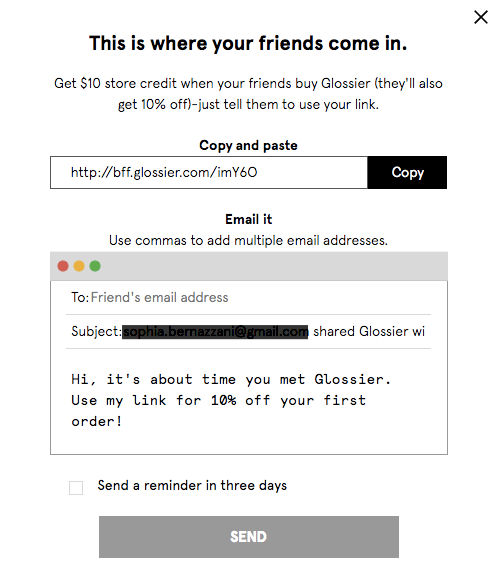How to Build a Customer Referral Program
One of the basic tenets of customer success is using your service to create advocates for your business. A happy army of satisfied customers can do a lot of legwork for you. And when word-of-mouth referrals make up 20-50% of most purchasing decisions (especially for new businesses and in emerging markets) why not take advantage of the opportunity?
But there’s a catch: assuming your customers will refer you to their connections simply because you provide exceptional service is idealistic at best. Referrals only happen out of the good of a customer’s heart some of the time — for the rest of it, giving customers a reason to refer will work wonders. As with most things in business, a plan is necessary.
Free Download: 45 Customer Referral Templates

If you’re looking to grow your business, retain the customers you already have, and reach your revenue goals, it’s time to implement a customer referral program. Simply having one is good business sense, because it reveals two things:
1. That you’re confident enough in your services and team to know that a referral program would be a positive investment and
2. You know that despite your good service, some customers might need a push to go out of their way for you.
How valuable is a referral?
A customer referral is highly valuable because it doesn’t cost you much — if anything — to acquire them. The exact value of a referral varies across different businesses, but it’s roughly the lifetime value (LTV) of a typical customer, plus the typical cost of customer acquisition (CAC), which you can then use to acquire additional new customers.
The reality is, however, that you’re effectively asking your customers to stand in place of your marketing and sales departments. And when referrals are the heart of generating new business, operating with tact, consistency, and patience is extremely important.

7 Steps to Start an Effective Customer Referral Program
1. Set Your Goals
Ask yourself: what do you hope to get out of this referral program? Are your goals tied more to growth and revenue? Do you want to add retention to that mix? Are you in an industry that requires an exceptional amount of trust-building? Once you decide what your goals are — and explicitly define them — the next steps should lay themselves out for you:
Discover how (if at all) referrals have been coming to your business.
Involve marketing, sales management, support — anyone who would be responsible for building customer relationships — and assess how they’ve been traditionally dealing with referrals. This will give you an idea of where you already are.
Do a little math.
What’s an existing customer worth? Compared to time spent monitoring and managing onboarding programs, how many referrals do you need to break even? A 10% conversion rate for referrals is, on average, a good starting point (and this, of course, is dependent on your business size and growth goals).
2. List Possible Referral Sources
We’ll call these advocates, and they can be anyone who you’re already connected with in the present, or who you have been connected to in the past. Begin listing them out. This list could include current customers, past customers, leads that may not have closed, industry leaders, your vendors, etc. This will give you solid footing to start out with.
3. Make a Plan to Reach Out
Now, refine. Narrow down the list of advocates and sources to a list of “inner circle” contacts. These are people who know what value your business has and would refer you without any incentive. Finding your inner circle isn’t a process that can be automated — you’ll get more benefit from this if you pull and segment these contacts manually.
Once you have your inner circle segmented out, you now have two things to take into consideration:
Timing is everything.
Identify appropriate times to ask these inner circle advocates to take part in your referral program. Because they are people you’ve worked with before, this is a less strenuous process starting out. When you start working with people who will need an incentive (which we talk about below), it’s important to consider the relationship. For some companies, depending on the service or product, asking for a referral needs to happen late in the relationship. For others, it could be upon the first sale (think apps, digital interface services).
Then, once you’ve asked, wait some more. That might require a waiting period of months, or even a year, to remind them about the referral program again.
Not all referrals are equal.
Be picky with your advocates (even your inner circle ones). Identify people who you think could market your brand the way that it should be marketed. Within that inner circle, who do you have a stellar, standout relationship with? Or do you have an existing customer that came from a referral and worked out? And remember: Watch out for referral fatigue, and make sure you’re not overburdening your contacts.
4. Identify Your Incentives
There are two options for a referral program: an incentive and a non-incentive program. A University of Chicago study found that non-cash incentives are 24% more effective at boosting performance than cash incentives. During this step, you should break your contacts out by levels and decide which ones can receive which offer.
And don’t forget the referrer — make sure they get something out of the deal, too. Take Airbnb for example: when a customer refers a friend, they get $20 credit — and when a customer first signs up, they get a credit towards their first trip over a certain amount.
5. Create Resources to Alert Your Customers
Once you have a referral program, create resources you think would work well, and alert your customers. Then, promote, promote, promote. And consider multiple avenues of promotion beyond the time-limited email campaign to remind your customers of the program’s existence. Those might look like:
- Newsletters
- Blogs
- CTAs & Email Signatures
- Product updates
Once you have the referral programs outlined, you’ll have an idea of what resources you need for each one. I’ve listed out a few resources you might need below:
- Emails for each type of contact telling them about your referral program
- A message explaining what types of customers fit well with your business. You need to paint a picture in their minds of your ideal customer
- A workflow that leads your contacts through the program and alerts your sales team when to call
- A landing page that provides a place for your contacts to give you their friend’s information
- Scripts for your sales and customer support teams to follow when explaining your referral programs
- A referral kit filled with resources for your contacts to share with their friends: this can include case studies, testimonials, eBooks, videos, anything that gives insight into working with your business
Whatever your medium, make sure it’s consistent, persistent (though not over-the-top) and in line with your program’s revenue, growth, and retention goals.
6. Set Up Tracking
Regardless of the size of your company (though this is especially relevant if your company has a larger customer base) you need to have tracking set in place. This will ensure that you don’t miss one detail — for referred accounts especially. You should be tracking:
- Who was referred and who referred them
- When they were referred
- Whether or not they converted or were sold
- How you’re going to nurture and follow up with them, etc.
If you don’t already invest in a CRM (customer relationship management) system, then now is a great time to become familiar! Keeping track of customer relationships is a huge component of customer success — the ability to individualize each account or relationship makes each customer feel like they’re a unique part of your base.
7. Say Thank You
Thank the referrer for helping you out (this is where incentives might work, but also consider messaging that thanks them specifically as well) and thank the referred for joining. Then, get to work — you’ve got happy customers to prove right.
Customer Referral Program Examples
1. Dropbox
Dropbox offers free products or services in exchange for users referring new customers: You can earn more cloud storage space in exchange for referring a friend.

Source: Medium
2. Acorns
When you refer a friend to Acorns, an online micro-investing service, you get $5 deposited in your account when they start investing. It’s called Acorns because it’s all about investing small amounts of money to accumulate wealth, so $5 goes a long way.
Sometimes, people just want money — but especially if they’re already using a money management app.

3. Stitch Fix
When you refer a friend to Stitch Fix, an online styling and shopping service, you get a $25 credit toward your next order — which covers the $20 fee paid toward your stylist and then some, meaning you only have to pay for the clothes you keep. Plus, your link allows your friend to skip the $20 styling fee, too.
It’s an easy step to go from telling someone where you got your outfit to sending them a link to try it themselves, so pairing that with a compelling credit or discount makes this program successful.

4. Evernote
Cloud-based note-taking app Evernote encourages referrals by offering reward points in exchange — points that can be accumulated and used for to upgrade to Evernote Premium, the paid version.
This program also gives the referred person a free month of Evernote Premium — giving them a taste of the paid version to incentivize them to start referring friends, too.

5. Glossier
Makeup and skincare brand Glossier‘s referral program is similar to Stitch Fix’s, but is helpful to encourage first-time or one-time purchases, too. Glossier offers mutual rewards for referring friends that gifts both people with credits toward their next haul.
It even has a nifty button that lets you gently remind your friend about the offer three days later.

6. Healthy Paws
Healthy Paws pet insurance has a referral program that gives the recipient a discount on their first month of coverage — and gives the referrer an Amazon gift card in exchange.
This program is smart to offer rewards, like an Amazon gift card, for their loyal customers — because as any pet owner knows, Amazon offers any and every food item, toy, leash, or outfit your pet could ever need (or not need), and they probably shop there for their pets already.

